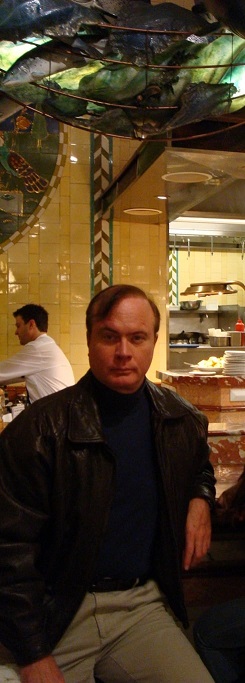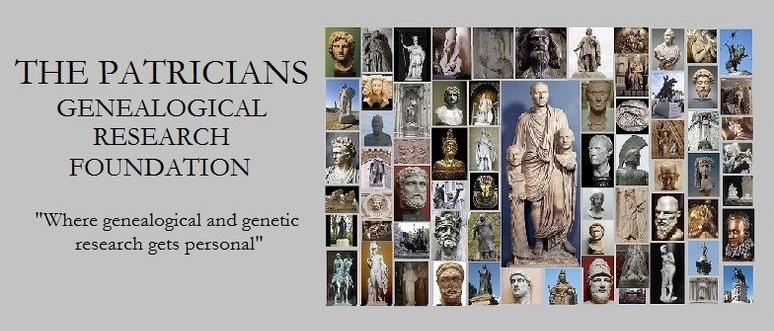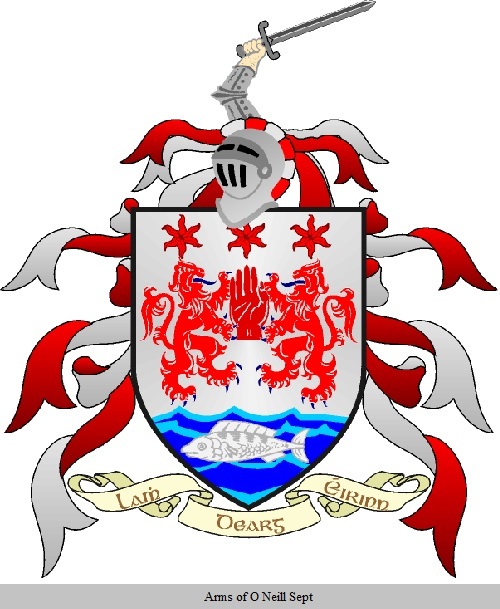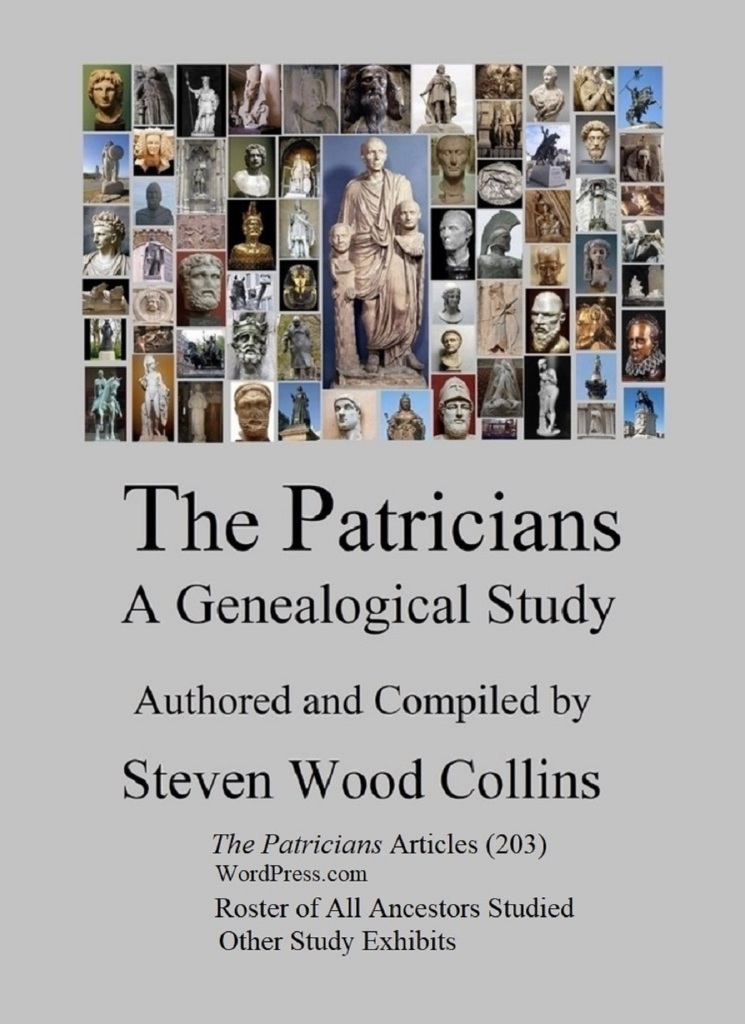

















Niall stood on equal footing with the likes of Alexander the Great and William the Conqueror as both a feared ruler and empire builder. As the first true ruler of all Ireland, his success as an invader put fear in the hearts of rulers of all nations within his reach. Niall made many incursions into Britain and Gaul, particularly in those areas formerly ruled by the Roman Empire.
As an agnatic descendant of Galamh mac Bile “Míl Espáine”, Niall was the primogenitor of the Uí Néill dynasty.
Caireann “Chais Dubh”, Niall’s mother, was a Brythonic Saxon princess captured by an Irish raiding party She later became a concubine of Eochaid Mugmedon mac Muiredach, the 122nd High King of Ireland. According to two slightly differing accounts of Irish High King tradition, she either died giving birth to Niall or lived as a menial until he ascended to the throne at Tara.
The entire succession of Irish kings finds its initial roots in Niul (Nel) Nemnach mac Farsaidof Egypt, Prince of Scythia (birth ca. 1350 BC). His father Foenius Farsaid was a Scythian king who helped Nimrod build the Tower of Babylon during the 16th century B.C. Foenius is credited with creating the Gaelic language (modern scholars also credit him as the founder of Hebrew, Greek, and Latin).
Niul’s father banished him from Crete for killing his brother during a row they had with one another. He made his way to Egypt where he soon befriended Pharaoh Semenkhkare, Pharaoh Akhenaton‘s son. Niul spoke 72 languages. He utilized the expertise to gain a ministerial position as a trusted and valued language interpreter and advisor to Cinqueris. He was so favored the pharaoh later gave him his daughter’s hand in marriage (Irish legend has it that Niul is the eponym of the Nile River). Their son Gaodhal Glas was the namesake of the Gaelic people.
During one of his raiding expeditions in Wales, Niall’s men captured a young lad who would later in life radically change Irish culture. St Patrick‘s (389 – 461) parents were killed right in front of him before being taken into captivity. His father, a descendant of Joseph of Arimathia who served as the Roman Governor of Cornwall, was a Roman official who also acted as a Hebrew-Christian (Japhethite) minister. His father was born in Armorica, France (ca. 300)
At that time, his Judaic lineage residing in Wales and Cornwall had already suffered egregious religious persecution, mainly at the behest of Celtic druid priests, by Munster rulers of the land for more than two centuries. Previously, Conan Meriadoc, King of Dumnonia (305 – 367), who was also a descendant of Joseph of Arimathia, led the migration of his people to resettle in Brittany, France, to escape the initial onslaught.
In the tradition of his father, Niall had the habit of enslaving common folk and his relatives alike, although it’s not clear that he recognized St Patrick as being from the latter camp. Niall brought Patrick back to Ireland, most likely selling the teenager to a druid priest who put him to work as a shepherd. After six years of enslavement, he fled to Britain following the urging of an angel who came to him one night in his sleep.
He returned to Ireland as a cleric who as a bishop baptized Conall Gulban – one of Niall’s sons who was the first Irish nobleman to receive the sacrament. Conall was the primogenitor of the Dunkeld dynasty of Scotland.
Niall may have been one of the most fecund males in Irish history. Though before a recent DNA study conducted in Ireland, academics had more than some doubt that he existed as more than a mythical Irish figure. However, as the study found that over 84% of Irish males possess his YDNA (R-M269), there’s little doubt now that Niall indeed lived and loved during the 4th century A.D. as his legend would have it. Moreover, both Conn of the 100 Battles(died about 464), Niall’s 6th great-grandfather, and Galamh mac Bile (1853 BC – 1805 BC), the ancient primogenitor Irish High Kings dynasty as well the Uí Néill sept, are of the exact same YDNA haplogroup.
Some interesting scientific facts about the R-269 haplogroup lend credence to ancient Irish lore concerning the advent of the Irish King dynasty almost three millennia ago:
-After 230 generations, the R1b-P297 haplogroup mutated to R1b-M269 between 7,000 and 11,000 years ago in the Pontic-Caspian stepperegion (present-day Ukraine).
-The Scythian empirethat flourished from the 8th to the 3rd century BC occupied most of that geographic territory before expanding out into eastern Europe and Eurasia, including Greece and Turkey (Partha).
–Niul Nemnach mac Farsaidof Egypt, Prince of Scythia, was born about 1401 BC in Nenual, Scythia (now Ukraine). He’s believed to have been the earliest renowned primogenitor of the Irish High King dynasty.
-Egyptian Pharaoh Akhenaten (died ca. 1336 BC), in a few pedigrees, Niul’s maternal great-grandfather, was of the M-R269 haplogroup.
This is a link to a list of surnames associated with the M-R269 haplogroup.
Led by Richard de Clare, 2nd Earl of Pembroke, the Norman invasion of Ireland in 1169 was the beginning of the end of the Uí Néill claim on the dynastic hegemony as sovereigns of Ireland, or significant parts thereof, that had lasted for over 2,500 years. Previously, Brian Boru (941 – 1014) successfully challenged that hegemony by asserting his own claim. The O’Brien clan would continue to vie with them for monarchal control of Ireland until they and High King Rory O’Connor sued for peace with King Henry II (1133 – 1199) in 1175, which effectively ended the High King dynasty forever.
The last pure-play pretender to the throne was Hugh O’Neill (1550 – 1616), Earl of Tyrone. He led the resistance of the King Henry VIII and Queen Elizabeth I agenda to bring all of Ireland under Crown control. He even managed to consolidate enough support amongst Irish nobility to act as the High King for a while. However, after his defeat at the Battle of Kinsale, he went into self-imposed exile five years later and never returned to Ireland thereafter. He died and was buried in Rome in 1616.
Both Niall and I are agnatic descendants of Irial Faidh MacEremoin, 10th High King of Ireland (784 BC – 741 BC).
Related blog articles:
Brian Boru (941 – 1014) Founder of the O’Brien Dynasty of Irish High Kings
Samuel Collins, MD (1619 – 1670) Personal Physician to Russian Czar Alexis I, Physicist
Columba Cilla of Iona, Apostle-Saint (521 – 597) founder of Iona Abbey and Nunnery
Conan Meriadoc ap Gereint (305 – 367) King of Dumnonia, Founder and 1st Duke of Brittany
Crínán of Atholl , Lay Abbott of Dunkeld (980 – 1045) Primogenitor of Dunkeld Dynasty
Other Geraldinum (Gherardini of Tuscany) Baron of Windsor (died after 1078)
John Fitzgerald Kennedy (1917 – 1963) Congressman, Senator, 35th U.S President
Mac Bethad mac Findlaích (ca. 1031 – 1057) King of Scotland, Eponym of Shake-speare’s “MacBeth”
Melusine de Lusina (734 – 759) Princess of Southern Picts of Alba, Countess of Anjou, Dragon Queen
Robert II Stewart (1316 – 1390) 7th High Steward, 1st House of Stewart (Stuart) King of Scotland
Saint Patrick of Ireland (389 – 461) 1st Bishop of Ireland, Patron Saint of Ireland
Niall Noígíallach of the Nine Hostages, High King of Ireland
Birth 380 in Ireland
Death 454 in Banks of the River, Loire, Rhone-Alpes, France
Ancestry.com citation/Lineages
43rd great-grandfather MACDONALD-FINLAY-COLLINS
46th great-grandfather DONNCHAD-DE CLARE-WARREN-CARRINGTON-HOLLAND-SIMMONS-COLLINS
49th great-grandfather (agnatic) COLLINS
49th great-grandfather MUMHAN-MACALPIN-LE ROY-MAULAY-REINE-LA POINTE-MOREAU GIROUX-MERON-BRULE
51st great-grandfather LORD OF ISLES-CAENMOR-PLANTAGENET-HOWARD-WOOD-COLLINS
http://trees.ancestry.com/tree/465887…
53rd great-grandfather COMYN-GRAHAM-SWINBURNE-HERON-COLLINGWOOD-COLLINS
1st cousin 53x removed AETHLING-WESSEX-HOWARD-WOOD-COLLINS
2nd cousin 52x removed AETHLING-WESSEX-HOWARD-WOOD-COLLINS
3rd cousin 53x removed COELING-CONSTANTINIAN-MEROVING-CAROLMAN-VERE-WARREN-HOLLAND-SIMMONS-COLLINS
FamilySearch (log in required)
SOURCES
Ancient individuals of R1b-M269 DNA Halpogroup (spreadsheet download link)
Ghosts of DNA Past: Irish Kings
List of haplogroups of notable people Wiki
Famous DNA: Niall of the 9 Hostages
Niall Mor Noígíallach DNA Study
FAB PEDIGREE: Mythical History of Ireland
FAB PEDIGREE: First Speaker of Early Celtic
BIBLIOGRAPHY
The Book Of Leinster Formerly Lebar Na Núachongbála
The Patricians, A Genealogical Study – Ebook Editions (Epub, PDF & Kindle) US$7.95


Steven Wood Collins (1952 – still living) Antiquarian, Genealogist, Novelist



